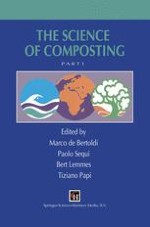1996 | OriginalPaper | Chapter
Dairy Cattle Slurry and Rice Hull Co-composting
Authors : P. L. Genevini, F. Adani, C. Villa
Published in: The Science of Composting
Publisher: Springer Netherlands
Included in: Professional Book Archive
Activate our intelligent search to find suitable subject content or patents.
Select sections of text to find matching patents with Artificial Intelligence. powered by
Select sections of text to find additional relevant content using AI-assisted search. powered by
A liquid dairy cattle slurry was composted using rice hull as absorbing matrix and bulking agent. The main results obtained were as follow: 1) The structure and size of rice hulls as well as their absorption capacity, made it possible to obtain a good compo sting mixture (moisture: 71.42 %; C/N ratio: 28.80 %; bulk density: 0.429 kg / dm3)2) The compost stability was reached after 56 days of composting, obtaining the follow data (% D.M.): ignition loss: 73.00: C/N: 18.36; TKN: 1.98; K: 1.84; P: 1.13; humified carbon: 4.60; respirometric index: 0.88 mg O2/gVS x h; dry matter yield: 57.34 %; organic matter yield: 50.05 %, water losses: 56.99 %; airflow-rate: max: 2.96 m3/kg D.M. x day., min: 0.28 m3/kg D.M., men 0.75 m3/kg D.M.. 3) The curing phase determined as aspected the reaching of a high compost maturity degree. After 256 composting days the data obtained (% D.M.): ignition loss: 65.89; C/N: 13.52; TKN: 2.51; K: 2.00; P: 1.27; humified carbon: 10.81; dry matter yield: 46.36 %; organic matter yield: 36.91 %, water losses: 63.99 %. 4) As shown by the organic matter yield, the mixture presented high degradability, in contrast to the literature (Chino et al., 1983). This can be explained by the composting temperature obtained (30 –45 °C) wich permitted high cellulose-like material degradation. 5)The compost data obtained, suggests that two marketable products are obtained: the first after 56 composting days, utilizable in field applications, and the second after 254 days, as substitute for organic substrata (e.g., peat) in greenhouses and on sensitive plants.
